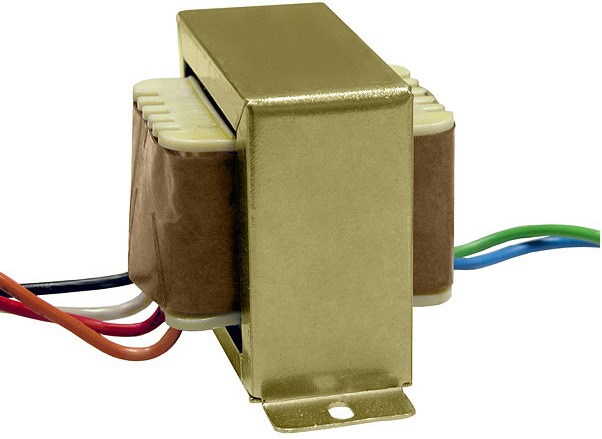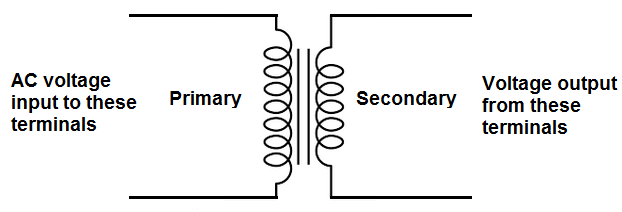How to Build a Transformer Circuit

In this project, we will show how to incorporate a transformer into a circuit.
A transformer is a very essential part for many types of circuits.
Transformers allow for a lot of different functionality in a circuit.
And they are widespread in use. Therefore, knowing how to use them is very important for circuitbuilding.
The first thing is, transformers are used when dealing with AC voltages. They don't work with DC voltages. But this is fine, because AC voltages are used widespread, as all household outlets operate from AC voltages. And transformers still are used with DC power because the AC voltages that transformers output can be converted to DC voltages. So transformers are used when dealing with AC or DC power. But chiefly they deal directly with AC power.
So we will now go over uses of transformers.
But first, know that there are basically 2 types of transformers. There are step-up transformers and step-down transformers.
Step-up transformers convert AC voltage to a larger AC voltage value. So, for example, it may step up 24VAC to 120VAC.
Step-down transformers convert AC voltage to a smaller AC voltage value. So, for example, it may step down 120VAC to 24VAC.
Depending on the use of the transformers, both are extremely important for different circuits.
Step-up transformers are used to build power inverters. Power inverters are devices that convert DC voltage to AC voltage. Being that power inverters are meant to be a kind of energy backup in case there is a power outage, it is meant operate at AC levels that wall outlets output such as 110V, 120V, 220V, 230V, or 240V. Being that the AC voltage is this high, the DC is always going to be lower than this. Typically, power inverters work off a single 12V DC battery. Therefore, we have to convert 12V up to either 110V-240V. Therefore, step-up transformers are needed to do so.
Another very important use up step-up transformers is for power conversion to a country's voltage supply. Let's say you are from a country that uses 220V of power from the AC mains power supply. And you go either visit or move to a country that operates at 110VAC. The devices you have may only operate at 220V of power. Therefore, you need a step-up transformer that converts 110V to 220V. Then, your devices can work.
These are very common uses of step-up transformers.
Step-down transformers have its uses as well. They're probably used even more.
This is because so many devices need to convert from the high AC voltage received from the mains power supply to a more lower DC voltage. How this is achieved is through a step-down transformer. The step-down transformer may convert 120VAC from mains to 12V by having a primary to secondary coil with a 10:1 ratio. The voltage output by the transformer is 12VAC. The circuit designer that uses components such as a full-wave rectifier, smoothing capacitors, and a voltage regulator in order to make the AC voltage DC. So through this, we can convert 12VAC to 12VDC.
And this type of circuit is very commonplace. Think of the devices that have a plug that plugs into a wall outlet but that really operates off of DC power. It's immense. This is why step-down transformers are even more widespread and used than step-up transformers. So many devices such as laptop chargers to DC power supplies all use step-down transformers to lower the high AC voltage to a more manageable AC voltage that can then be converted to DC power.
So practically all devices that operate from DC power that plugs into an AC mains outlet uses a step-down transformers.
And of course step-down transformers are also used when you need to power convert going from a country that uses a lesser power to a country that uses a greater power.
So, knowing all these uses of transformers, whether step up or step down, shows how important transformers. They're vital for many, many circuits, practically all circuits that have a plug. Probably the only circuits you don't need them for is if you are battery-operated devices or devices that you power directly with a DC power supply.
So, in this circuit, it's very simple, we demonstrate how to connect a power transformer so that we can have it operating in a circuit.
Components Needed
- Power Transformer
- AC Voltage Source
In this circuit, we will use a step-down transformer.
The step-down transformer that I have is a 120V primary 24V secondary transformer.
This means that the transformer takes an input of 120VAC and converts into down to 24VAC.
So this is the equivalent of taking a device that plugs into AC mains in a United States outlet and getting 24VAC as output.
So this makes it more manageable to convert this lower AC voltage into DC voltage. Most devices operate on DC voltages of 12V or less. So if we tried to convert 120VAC directly into DC voltage without converting it down, that would disastrous and excess power for the circuit.
Therefore, transformers are vital.
Transformer Circuit
The circuit which demonstrates how to incorporate a transformer into a circuit is shown below.

The breadboard circuit of the circuit above is shown below.

So a power transformer has 2 sides. One side is the primary coil and the other side is the secondary coil.
How a transformer works is based on the ratio of coils of one side to the other. The side that has a greater of amount of turns relative to the other will have a larger voltage. So, a step-down transformer has a greater amount of turns at the primary side than the secondary side. If the turns ratio is 10:1 in favor of primary to secondary, the voltage at the primary side will have 10 times larger, so the voltage at the secondary end will be 10 times smaller. So if the input voltage is 120VAC, the voltage at the output will be 12VAC.
A step-up transformer is the opposite. The turns ratio is greater at the secondary coil. Therefore, the voltage is greater at the secondary end. If a 1:10 turns ratio in favor of secondary, the voltage will be 10 times larger at the output than input. So if the transformer takes in 12V, it will output 120V.
How the transformer works is through the process of voltage induction. The primary coil, which receives the input voltage, induces a voltage at the secondary coil. The amount of voltage induced depends on the turns ratio, as discussed above.
So the primary coil is where we attach the input voltage to that we want to convert.
So if we're operating a step-down transformer, a 120VAC primary 24VAC secondary, we attach the 120VAC to the primary coil. The output of the secondary coil is the 24VAC.
Each side, primary and secondary, will have a minimum of 2 terminals each. This is because voltage has positive and negative terminals.
So, for the primary coil, to terminal we attach the positive end of the voltage source of the 120VAC and to the other terminal, we attach the negative end of the voltage source of the 120VAC.
Not all transformers will have 2 terminals. Some transformers will have a third terminal for ground. But all will have at least 2 terminals.
Also, for the secondary coil, there will be at least 2 terminals. One for the positive end of the voltage and the other for the negative end of the voltage.
Again, some transformers may have more than 2 terminals at the secondary coil. This is because some transformers have multiple terminals for different voltage outputs. What is meant by this is that some transformers have more than 1 voltage that can be output. Some transformers output either 12V or 24V, for instance.
And this is all that is required for transformers to work.
It's pretty fundamental.
Also note that step-up and step-down transformers, although not intended, can be switched and used as the other. What is meant is that step-down transformers can be used as step-up transformers if the secondary coil is used as the input and the primary coil is used as the output. You just have to make sure that neither power rating of the secondary coil isn't exceeded. For, example, if the secondary coil is rated for 24V, do not exceed this by feeding into it a greater voltage. This is the reason why it's better to use power transformers for its intended use, but it still can be done if power is allocated properly.
And this is how a transformer is incorporated into circuits.
Related Resources
How to Build a Square-to-Triangle Wave Converter Circuit
How to Build a Square-to-Sine Wave Converter Circuit
How to Build a Clock Circuit with a 555 timer
How to Build an Astable Multivibrator Circuit with Transistors
How to Build a Multivibrator Circuit with a 4047 chip (for astable mode operation)
How to Build a Voltage-Controlled Oscillator Circuit with a 4046 Chip
How to Build an Oscillator Circuit with a 7414 Schmitt Trigger Inverter Chip
How to Build a Sine Wave Generator Circuit with a 555 Timer
How to Build a Ramp Generator with Transistors
How to Build a Voltage-controlled Oscillator with a 555 Timer Chip
